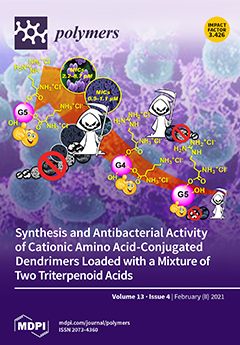Poly(3,4-ethylenedioxythiophene) (PEDOT) plays a key role in the field of electrically conducting materials, despite its poor solubility and processability. Various molecules and polymers carrying sulfonic groups can be used to enhance PEDOT’s electrical conductivity. Among all, sulfonated polyarylether sulfone (SPAES), prepared via homogenous
[...] Read more.
Poly(3,4-ethylenedioxythiophene) (PEDOT) plays a key role in the field of electrically conducting materials, despite its poor solubility and processability. Various molecules and polymers carrying sulfonic groups can be used to enhance PEDOT’s electrical conductivity. Among all, sulfonated polyarylether sulfone (SPAES), prepared via homogenous synthesis with controlled degree of sulfonation (DS), is a very promising PEDOT doping agent. In this work, PEDOT was synthesized via high-concentration solvent-based emulsion polymerization using 1%
w/
w of SPAES with different DS as dopant. It was found that the PEDOT:SPAESs obtained have improved solubility in the chosen reaction solvents, i.e.,
N,
N-dimethylformamide, dimethylacetamide, dimethyl sulfoxide, and
N-methyl-2-pyrrolidone and, for the first time, the role of doping agent, DS and polymerization solvents were investigated analyzing the electrical properties of SPAESs and PEDOT:SPAES samples and studying the different morphology of PEDOT-based thin films. High DS of SPAES, i.e., 2.4 meq R-SO
3− g
−1 of polymer, proved crucial in enhancing PEDOT’s electrical conductivity. Furthermore, the DMSO capability to favor PEDOT and SPAES chains rearrangement and interaction results in the formation of a polymer film with more homogenous morphology and higher conductivity than the ones prepared from DMAc, DMF, and NMP.
Full article






